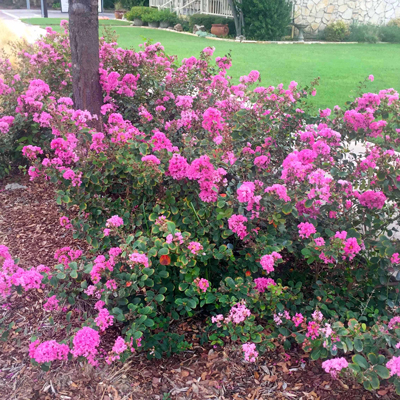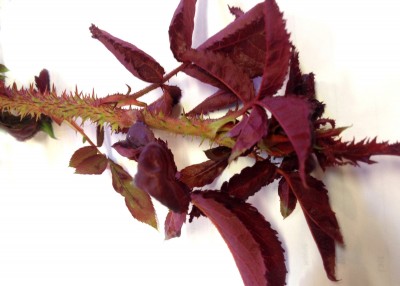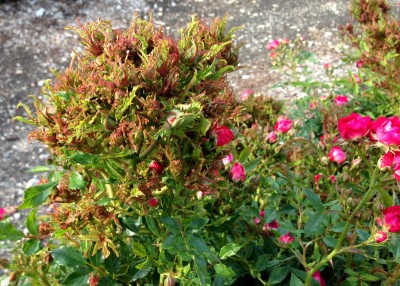Rose Rosette Virus

The question begins, “Neil, my rose is behaving strangely. It has strong bull canes that are absolutely covered with thorns. Other canes appear normal. However, the buds never open properly, and the plant seems to be stunted and losing ground. What could the problem be?”
Rose rosette disease (“RRD”) is not new. In fact, it’s been known to exist for decades. However, for whatever the reasons, it has proliferated in DFW and elsewhere in Texas over the past several years. Tens of thousands of roses have been afflicted, and at present there seems to be no prevention or remedy for it.
What we know:
- RRD causes erratic growth of affected plants.
- Canes are malformed, almost as if a broadleafed weedkiller might have drifted onto the plants.
- Affected canes are coated with hundreds of aggressive thorns – several times the normal number.
- Other canes will appear normal, BUT the entire plant is infected if any part of it is.
- The disease is spread by microscopic mites that are easily transferred from plant to plant and yard to yard. The mites are even carried by the wind. You will not be able to see the mites.
- There is no prevention or cure for RRD. Pruning to remove the obviously infected canes alone will not help. Remember: the entire plant is infected if any part of it is.
- You will see references to home remedies. These do not work, and they serve only to allow the disease to spread while the gardener is trying futilely to save existing plants.
- As soon as you identify RRD in your garden, you should remove all affected plants, roots and all. Carefully place them in large plastic trash bags and send them out with the trash. Do not try to shred and compost them.
What we do not know:
- How long you must wait before planting new roses back into the same soil? I hear varying recommendations from within a couple of weeks to one or two years. Honestly, if this were attacking my roses, I’d put any new rose plantings in fresh soil somewhere else in my garden, at least for now.
- Specifically, which varieties are vulnerable? Certainly the Knockout® family has been hit the worst, but that’s probably since they have been planted so extensively, often in masses in large beds. Other roses are also susceptible. Research is underway to determine which types are most and least likely to develop the problem.
- Where will we find a remedy? Breeders, I am told, are working with the genetics of their roses, even to the level of work within laboratories, to find resistance. I’m not an expert in this field, but I have heard no mention of a consumer miticide to control the mites. Honestly, I’m not sure anyone knows where we will find help for our roses, but the nursery industry has invested millions of dollars into the research projects.
If you think you may have infected plants
- Take photographs and compare them to the ones you see here. Once you have seen RRD (as in these photographs), you will know how to recognize it (click thumbnails to view larger images).
- Take photographs to a Texas Master Certified Nursery Professional for help in confirming presence of the disease. DO NOT take actual plant samples into nurseries. If you do have RRD on your roses, don’t take the chance of spreading it to healthy nursery stock.
- Immediately upon confirmation of the disease, remove all affected plants as described above.
What information is available online?
A Facebook friend shared this really helpful and academically-driven compendium of information. I think you’ll find it useful. https://roserosette.org
What can be planted to replace the roses?
Without wanting to sound like I’m avoiding the question, I do have to say that roses are unique plants. No replacement shrubs or vines will be exact replacements. It’s important to note that RRD afflicts only roses. You don’t have to worry about other types of plants picking up the disease.
If you’re looking for the best low to mid-sized shrubs, consider the various types of dwarf hollies, nandinas, dwarf abelias, low junipers and other woody plants that are adapted to your part of Texas. Your local independent nursery can fine-tune your options.
Perennials are another good choice, especially if you’re seeking color in the old rose bed. You have scores of types from which to choose. Choose varieties that will give you a nice succession of blooms. Be mindful of their flowering times, mature heights and colors. It’s wise to plant a few evergreen woody plants to anchor the bed visually during the winter dormant season.
Annuals are quick and easy. They’re also affordable, and most will be colorful for five or six months each summer. Determine what height you want them to grow and what colors you want, then let your nursery professional suggest some of the best. As with perennials, the bed will look better if you anchor it with a few evergreen shrubs.

All of that said, I was running errands a year or two ago when I came across a planting that struck me as the perfect replacement for Knockout® red roses.

Dwarf crape myrtles bloom for several months and in more or less the same colors as roses. Both plants are deciduous, and they grow to be about the same height. Choose whichever you like from the ones I’ve listed above, but as for me, the Petite series of crape myrtle will be my first choice.
Support information
I have accumulated several good pieces of information pertinent to RRD. A couple of these are several years old, but what they say is still highly relevant.
From Texas AgriLife Extension and my friend Dr. Mike Merchant http://citybugs.tamu.edu/2011/07/13/rose-rosette-disease-transmitted-by-a-mite/
http://www.hgtvgardens.com/garden-basics/blooms-off-tackling-a-rose-killer
Also from Neil's Notes...

Steps to Re-landscaping Your Home
Landscapes are not “forever” improvements. Like most other elements of home ownership, they’re never static. Eventually, for whatever the reason, it becomes time to remodel your gardens. It can be overwhelming, until you break it …










Thanks for the valuable info, Neil. I’m sosad to lose all my K-O roses! I’ll take your advice and not replant a climber in that bed. Oh well…
Noooo, I have a rose bush grown from a cutting of my grandmother’s bush that was brought to Ky in a Conestoga wagon.
Thanks!
We had to dig ours up last fall!! It was awful!! It was the strangest thing I have seen!
We had to dig ours up last fall!! It was awful!! It was the strangest thing I have seen!
The Collin County Rose Society has information on our web site about RRD. We have formed a coalition with Texas Agri Life and CC Master Gardners to help educate the public about RRD. Would love to have anyone visit our meeting on Friday, March 13. More info is on our website – Collin County Rose Society.
I saw similar mutations on upright Confetti Lantana at the end of last summer. I hope is was something else.
If I have one with this and another beside it that is now normal, do I need to remove it too or just watch it?
We have 35 rose bushes–about 20 of them knock-out roses. We will need therapy once we have to start pulling them out. Sad.